Mark Prein and Madan M. Dey
WorldFish Center
GPO Box 500, 10670 Penang, Malaysia
Prein, M. & M.M. Dey. 2006. Community-based fish culture in seasonal floodplains. In M. Halwart & A.A. van Dam, eds. Integrated irrigation and aquaculture in West Africa: concepts, practices and potential, pp. 17–26.Rome, FAO. 181 pp.
Abstract
During the rainy season in extensive river floodplains and deltaic lowlands, floods lasting several months render the land unavailable for crop production for several months each year. These waters are considerably underutilized in terms of managed aquatic productivity. This raises the opportunity to enclose parts of these floodwater areas to produce a crop of specifically stocked aquatic organisms aside from the naturally occurring “wild” species that are traditionally fished and are not affected by the culture activity, overall resulting in more high-quality, nutrient-dense food production and enhanced farm income for all stakeholders, notably the poor. The WorldFish Center and its national partners recently tested the concurrent rice-fish culture in the shallower flooded areas and the alternating rice-fish culture in the deep-flooded areas of Bangladesh and Viet Nam through a community-based management system. Results indicate that community-based fish culture in rice fields can increase fish production by about 600kg/ha/year in shallow flooded areas and up to 1.5tonnes/ha/year in deep-flooded areas, without reduction in rice yield and wild fish catch.
Introduction
The past decade has seen growing recognition of the crisis facing the world's water resources and the need for concerted action to use these more efficiently. The efficiency of water use (or water productivity)can be increased by producing more output per unit of water used, or by reducing water losses, or by a combination of both. So far, strategies for increasing output have been limited to crop cultivation only. Water productivity at several organizational levels can be increased further by integrating fish and other living aquatic resources into the existing water use systems. Such opportunities of integration include community-based fish culture in irrigation schemes and seasonal floodplains.
A variety of studies show that reservoirs and canals of irrigation systems continue to yield substantial fish harvests, which are important sources of protein and livelihoods for the poor and landless households. Yet the current use of irrigation systems and floodplains for fish production falls far short of potential. In seasonal floodplains, fish production essentially emanates from capture activities by seasonal or part-time fisher-farmers where wild fish enter, reproduce and are harvested from the flooded fields. In Cambodian floodplains, the value of fish caught through trap ponds within rice fields reaches 37 to 42 percent of that of rice production (Gregory and Guttman, 1996; Guttman, 1999).
A number of studies have been conducted in the 1980s to test the technical feasibility of culturing fish in seasonally flooded rice fields in India (Roy et al., 1990; Das et al., 1990; Mukhopadhyay et al., 1991), Bangladesh (Ali et al., 1993, Ali et al., 1998), Cambodia (Gregory and Guttman, 1996; Guttman, 1999, 2000), and Viet Nam (Rothuis et al., 1998a; Rothuis et al., 1998b). These studies show that fish production can be increased by more than 1tonne/ha/year by stocking flooded ricefields with fish (i.e. individual farmers fencing their plots and stocking fish during the flood season). In addition, the culture of fish within rice fields can increase rice yields, especially on poorer soils and in unfertilized crops where the fertilizing effect of fish is greatest (Halwart, 1998). Savings of pesticides and earnings from fish sales lead to increased yields and result in net incomes that are 7 to 65percent higher than for rice monoculture (Halwart, 1998). But the adoption of this technology by farmers has been very low due to the high cost of fencing individual plots.
Fig. 1. Farming System Evolution in Floodprone Areas (1/6)
| Best Traditional System (until 1970s) |  |
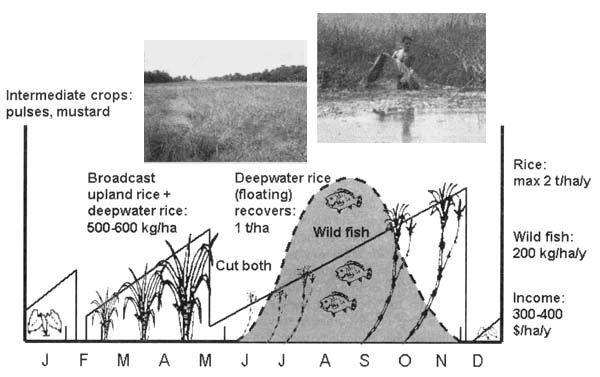
Recently the WorldFish Center established a new approach in Bangladesh and Viet Nam, where fish is cultured communally during the flood season and the same land is cultivated with rice during the dry season individually. The results of initial trials show an additional 10 percent lower cost of rice production and a net return from fish production of 400US$/ha in the Ganges and Meghna floodplains (Bangladesh), 340US$/ha in the Red River Delta (Viet Nam), and 220US$/ha in the Mekong Delta (Viet Nam). Significantly, these benefits were obtained with no reduction in the wild fish catch, composed mainly of small indigenous species (SIS). The returns from the sale of the produced fish were distributed among the group members according to a sharing arrangement that was pre-negotiated among group members at the beginning of the season. Gains to the landless were in form of cash income, which was significant as they did not have any alternative income generating opportunities.
There are many options for enhancing food production from fish in managed aquatic systems. The most appropriate technology will vary from country to country and site to site. Additionally, the social and economic conditions under which these technologies can be implemented need to be understood. Although our recent studies in Viet Nam and Bangladesh demonstrated the feasibility of the community-based fish culture systems, much more work is needed to understand the social and economic viability of these approaches under different socio-cultural and institutional environments, and to design appropriate institutional arrangements for different social settings. Similarly, the governance arrangements for fish culture in irrigation systems (canals, fields, reservoirs) also require detailed analyses if the full social value of these resources is to be harnessed.
At the ecosystem or basin level, water provides a wide range of goods and services, all of which need to be considered in broader analyses of the value obtained from water. Most of the previous studies of water productivity have concentrated on measuring the value of crop production only and excluded the existing and potential contributions by living aquatic resources. There is therefore a need not only to increase water productivity, but also to improve the methodologies for measuring water productivity.
Fig. 2.1. Farming System Evolution in Floodprone Areas (2/6)
| Moderately Deep Flooding Land: Rice followed by Deepwater Rice (1980s…) |  |
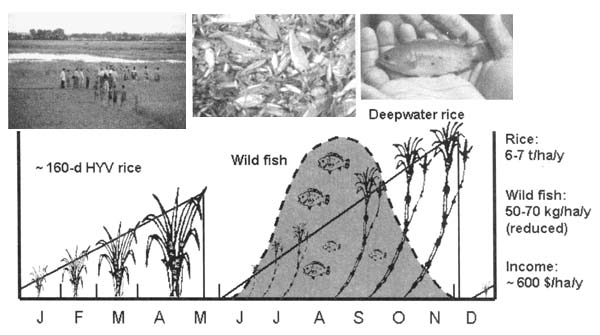
Fig. 2.2. Farming System Evolution in Floodprone Areas (3/6)
| Dry Flooding Land: HYV - ‘Green Revolution’ followed by Fallow (1980s – 1990s) |  |
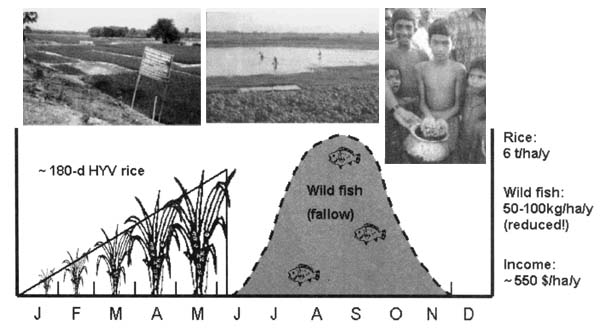
Fig. 3.1. Farming System Evolution in Floodprone Areas (4/6)
| Moderately Deep Flooding Land: Rice followed by Deepwater Rice+Fish (2000s…) |  |
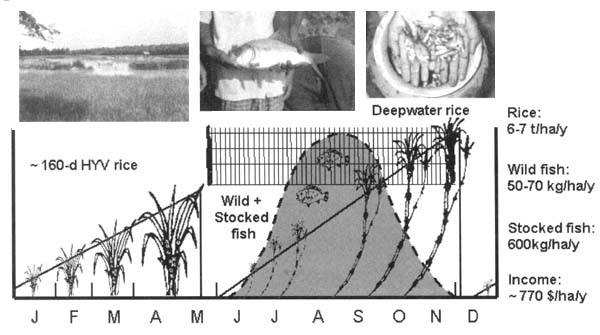
Fig 3.2. Farming System Evolution in Floodprone Areas (5/6)
| Deep Flooding Land: Rice followed by Fish-only (2000s…) |  |
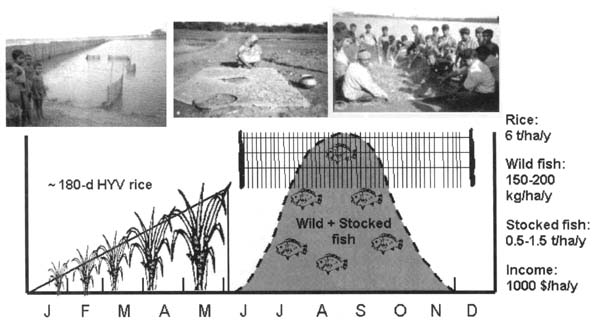
Floodplain farming system evolution
Farming practices in the flood-prone ecosystem are governed by a number of interacting physical factors, of which the chief ones are the flooding regime (onset, depth, recession, and variability), topography, rainfall pattern, soil texture and water management regime. Traditionally, farmers used to grow deepwater rice and capture fish during the rainy/flood season and subsequently cultivate a wide range of crops (such as pulses, oil seeds, and vegetables) during the post-flood dry season (Figure 1). In Gangetic floodplains (Bangladesh and eastern India), farmers used to get a maximum 2 tonnes of traditional rice and approximately 200kg of wild fish per hectare per year with an average income of about US$300 per hectare per year.
During the last few decades, the flood-prone ecosystems in Asia have undergone some dramatic changes due to the establishment of deep wells (for example, in Bangladesh and eastern India) and construction of the Flood Control Drainage and Irrigation (FCDI) systems. With the availability of irrigation facilities, farmers grow high yielding varieties (HYV) of rice in the dry season under irrigated conditions. In Gangetic floodplains the dominant farming pattern in shallow flooded areas is irrigated HYV rice during the dry season followed by transplanted deepwater rice varieties during the rainy seasons (Figure 2.1), while the dominant pattern in deep flooded areas is single-crop irrigated HYV rice (Figure 2.2). Late harvest of HYV dry season (winter) rice does not allow timely establishment of a deepwater rice crop in the deep-flooded areas during the rainy season.
In shallow flooded areas in the Red River Delta (in northern Viet Nam), farmers generally grow high yielding irrigated rice during the dry season, and a tall-growing local or higher yielding variety during the rainy season. In the Mekong Delta of southern Viet Nam, where rice fields are also deeply flooded in the rainy season, two irrigated crops of high yielding rice varieties are grown with a flood fallow period in between. Although the introduction of irrigation-based “green revolution” technology has increased the total rice production in flood-prone areas (from about 2tonnes/ha/year to about 6–7 tonnes/ha/year), the wild fish harvest from flooded rice fields has declined substantially (from 200kg/ha/year to less than 100kg/ha/year).
An opportunity for further increased production in the flood-prone ecosystem is the integration of fish culture with rice farming. The flood-prone areas are seasonally flooded during the monsoon and remain submerged from 4 to 6months. In these flood-prone areas, land ownership is fixed according to tenure arrangements during the dry season. But during wet season floods, individual land holdings are not visible and waters are a community property granting all members access to fish in all areas of the community. Therefore, it is essential that the rice-fish culture activity in the flood-prone ecosystem is undertaken by the rural community under a group approach. The group should include the landless who have traditionally accessed the flooded areas for fishing, but would lose this essential resource if they were denied access because the areas are stocked with fish.
Generally, three types of rice-fish culture systems can be established in flood-prone areas: (i) concurrent culture of deepwater rice (with submergence tolerance1) with stocked fish during the flood season followed by dry season rice in shallow flooded areas; (ii) concurrent culture of deepwater rice (with elongation ability2) with stocked fish during the flood season, followed by dry season non-rice crops; and (iii) alternating culture of dry season rice followed by stocked fish only during the flood season (that is, without rice) in the enclosed area (for example, as in a fish pen).
The WorldFish Center and its national partners recently tested the concurrent rice-fish culture (option i above; Figure 3.1) in the shallower flooded areas and the alternating rice and fish culture (option iii above; Figure 3.2) in the deep-flooded areas of Bangladesh and Viet Nam through a community-based management system. Results indicate that community-based fish culture in rice fields can increase fish production by about 600kg/ha/year in shallow flooded areas and up to 1.5t/ha/year in deep-flooded areas without reduction in rice yield and wild fish catch. These (as also shown in Figure 4) and other potential technical options need to be tested and validated in various floodplains of Asia and Africa under varying institutional arrangements suitable for locally prevailing socio-cultural-economic and political conditions.
| Fig.4. Seasonal Floodplains: Two Options for Improvement of Farming Systems through Community-Based Fish Culture |  |
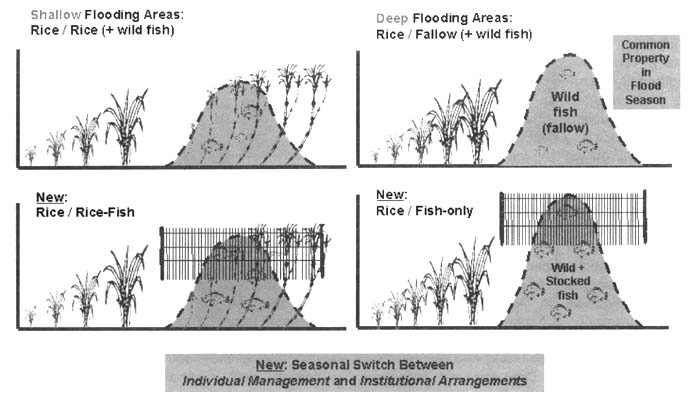
Conclusions from recently conducted trials
In the trials conducted over a three-year period in Bangladesh and northern and southern VietNam, the approach taken was that communities were encouraged to determine the management criteria and institutional arrangements which they considered suitable to their local conditions and social environment. Further details are provided in Dey and Prein (in press).
Institutional arrangements
Arrangements between stakeholders are necessary within the context that during the flooded season when individual plots are not discernable, the water body becomes a temporary common property, in contrast to the dry season when individual land holdings are clearly discernable and respected; this approach is needed to exploit the resource.
A group approach is used with around 20 households per group, comprising landowners, fishers of the community and landless labourers (with customary access rights for fishing in the flood season). Benefit arrangements are required to organize and consolidate the group. Landowners comprise participating (active) and non-participating (passive) persons. Landowners participating actively in the group activities receive an additional share of benefits for their role as group members (on top of the share they already receive through mere provision of their land).
It was found that existing social harmony among the groups before the introduction of the community-based fish culture approach was a requirement for its successful implementation. Artificial memberships based on previous linkages with facilitating organizations (e.g. NGOs) proved to have destabilizing effects or were even detrimental. The predisposition of the population to community-based activities in some countries also was an important determinant. For example, in southern VietNam farmers were highly averse to any form of group arrangements, even if these involved close relatives, and preferred individual management of smaller, individually owned and controlled areas. Further assessments on the attributes of successful group approaches and the reasons for spontaneous adoption and spread of the technology are planned in the near future.
Selection of concurrent versus alternating system
The selection is dependent upon the flooding pattern in the area and the preferences among the groups.
Selection of appropriate sites
The sites should be topographically suitable areas, and there is a need to include as much as possible existing embankments. Initially the number of suitable sites was perceived to be limited, however, “spontaneous adopters” fenced up to 75percent of the perimeter (rest were existing embankments) at a comparatively high cost. Nevertheless, these sites still proved to be highly profitable.
Fish species, stocking densities, sizes
Recommendations were given on stocking densities of several fish species in a polyculture, preferably of larger sizes to avoid predation and to achieve greater sizes at harvest. However, these were not prescriptive packages (to avoid straightforward rejection), and the actually stocked numbers of individual fingerlings and species proportions depended on the local availability from hatcheries and other sources. Given the size of some of the enclosed areas, these were large numbers, far greater than the usual requirements for fish ponds, which together with the preference for larger sizes and several different species posed considerable logistical challenges (sourcing, transport) to the communities and the facilitating NGOs.
Market supply versus timing of harvests
Both the capture phase for wild fish and the harvest phase are bound to coincide as they depend on the flood duration, levels and recession pattern. However, the culture operation can be staged over a longer period through sequential harvests leading to thinning out of the standing fish stock for higher growth and greater returns. Further, deeper pits in the area can be used to keep fish beyond the normal capture season until fish prices increase and greater returns from markets can be achieved. This was done by some of the trial groups.
Financial management issues
In the first year the communities received financial support for the initial investment in fences. In subsequent years, communities were expected to re-invest a portion of their proceeds from the previous year's fish sales into the subsequent year's fish culture operation, e.g. for the purchase of fish fingerlings and the maintenance of the fences.
Effects on biodiversity (wild fish)
It was generally concluded that wild fish biodiversity and abundance was not affected by the culture operation, although no specific analyses were conducted as part of these early trials. The conclusion is based on comparisons of wild fish catch both in terms of biomass and species composition, which was essentially similar, except for predators such as snake head (Channa sp.) and catfish (Clarias sp.), which were reduced. However, in some cases farmers observed that the biomass of small indigenous species was considerably higher than in neighboring unfenced areas, and few species which had previously been rare in their areas, had appeared again in their catches in the fenced areas. This was attributed to the strongly reduced abundance of predators within the fenced area. More detailed studies are required to validate that stocking fish into fenced areas of seasonally flooded waters has no negative effects as well as that the fences limit access of juvenile predatory fish into the fenced areas with the incoming/rising floods.
Beneficiaries and impact
Inland fishes in general have been characterized as the most threatened group of vertebrates used by humans, with a constant negative trend. These fish are of highest importance for the rural poor for income, nutrition and food security, but the demand is increasing which is reflected in constant price increases. Fish also have a high value for nutrition of the poor due to their nutrient density and quality (protein, lipids, micronutrients) that is in highly bio-available form in most small fish species.
Fish production from the fenced floodplain areas will be increased at least two to tenfold over the natural catch through the culture activities, as shown from our previous work in Bangladesh and Viet Nam. Harvests are in bulk and therefore are sold on the market producing cash returns that are shared among group members, including the landless. Capture of non-stocked, small indigenous species by landless with traditional fishing methods within the culture areas during the culture period is specifically permitted by the groups, and thereby ensure their continued supply of protein and income over the culture season from the fenced areas. Cash income will increase for all involved, notably for the landless relative to their base income. We expect similar levels of benefits from group-based fish culture approaches in irrigation systems.
In the longer term, the approach aims at providing the rural populations in the floodplain areas and irrigation systems of the targeted basins with an equitable source of additional income and supply of fish, both from natural fish production, as well as from stocked culture species. This will directly benefit the members of the communities involved, but also fish consumers outside the culture areas due to increased supply on the markets, thereby countering the negative trend of inland fisheries production. Revenues from fish production can also be used to improve the maintenance and hence the sustainability of irrigation systems.
Extrapolation domains
The potential application areas for the community-based fish culture approach in floodplains and irrigation systems are considerable. These areas are usually densely populated, the seasonal floodwaters, however are underutilized.
The approach helps mitigate the trend of declining inland capture fisheries production, with increasing prices of fish, rendering these less affordable to the poor. For example, in Bangladesh alone, there are 3 million hectares of medium and deep flooded areas, out of which about 1.5 million hectares are estimated to be suitable for community-based fish culture. If this approach is adopted in only 50 percent of these areas, annual fish production will increase by 450000 tonnes (additionally to presently produced 60000 tonnes of wild fish caught in these areas) at an approximate value of US$340 million and will be of benefit to an estimated 6.7 million people (2.7 million of which are landless and/or functionally landless). Similar opportunities are seen for floodplain and deltaic systems in other countries in Asia and Africa.
In the Mekong river basin, 0.8 million hectares of medium and deep-flooded areas exist which could be utilized by the communities living in them for joint fish culture activities during the flood season, which is otherwise a fallow season with very low economic and agricultural activity. Of 5.2 million hectares of medium and deep flooded areas the Indo-Gangetic basin, 3 million hectares are in Bangladesh, wherein an estimated 27 million potential direct beneficiaries live. If only 25 percent of these adopt the approach, 6.7 million would benefit, of which 2.7 million persons are landless. Other seasonally flooding areas suitable for the approach in other basins in Asia are in Myanmar (1.2 million hectares), Thailand (0.7 million hectares), and the Red river delta in Viet Nam (0.1 million hectares).
In Africa, the potential for application of community-based fish culture is greatest in seasonal floodplains and in irrigation schemes. In West African floodplains, 470000 hectares are used to grow deepwater rice (Catling, 1992) which could be used for concurrent deepwater rice and fish culture.
References
Ali, M.H., Miah, M.N.I. & Ahmed, N.U. 1993. Experiences in deepwater rice-fish culture. Bangladesh Rice Research Institute Publication No. 107, Gazipur, Bangladesh. 28 pp.
Ali, M.H., Miah, M.N.I. & Elahi, M.N. 1998. Increasing farm income by incorporating fish culture in deepwater rice environment. Bangladesh Journal of Fisheries Research, 2(2): 183–188.
Bakker, M., Barker, R., Meinzen-Dick, R.S. & Konradsen, F. (eds). 1999. Multiple uses of water in irrigated areas: a case study from Sri Lanka. SWIM Report 8. Colombo, Sri Lanka: International Water Management Institute. (also available at http://www.cgiar.org/iwmi/pubs/ SWIM/Swim08.pdf).
Catling, D. 1992. Rice in deep water. London, MacMillan Press and International Rice Research Institute. 542 pp.
Das, D.N., Roy, B. & Mukhopadhay, P.K. 1990. Fish culture with DW rice in West Bengal. In: Deepwater and Tidal Wet Land Rice Bulletin, No. 17, November 1990, International Rice Research Institute, Philippines.
Dey, M.M. & Prein, M. 2000. Case 3: Fish in deepwater ricelands. In PRGA Program. ed. Equity, well-being, and ecosystem health: participatory research for natural resources management, p. 19–20. CGIAR Program on Participatory Research and Gender Analysis, CIAT, Cali, Colombia. 62 pp.
Dey, M.M. & Prein, M. 2003. Participatory research at landscape level: floodprone ecosystems in Bangladesh and Vietnam. In B. Pound, S.S. Snapp, C. McDougall & A.Braun, eds. Uniting science and participation for sustainable livelihoods and adaptive natural resource management. Earthscan/IDRC.
Dey, M.M. & Prein, M. Community-based fish culture in seasonally deep-flooding ecosystems. IFAD Technical Advisory Notes 1, Aquaculture Series, IFAD, Rome (in press).
Dey, M.M. & Prein, M. Community-based concurrent rice-fish culture in seasonal moderately deep-flooding ecosystems. IFAD Technical Advisory Notes 2, Aquaculture Series, IFAD, Rome (in press).
Dey, M.M. & Prein, M. Community-based fish culture in seasonally flooding ecosystems. WorldFish Center Technical Report (in prep.).
Gregory, R. & Guttman, H. 1996. Management of ricefield fisheries in South East Asia: capture or culture? ILEIA Newsletter 12(2): 20–21.
Guttman, H. 1999. Ricefield fisheries - a resource for Cambodia. Naga, The ICLARM Quarterly 22(2): 11–15.
Halwart, M. 1998. Trends in rice-fish farming. FAO Aquaculture Newsletter 18: 3–11 (also available at http://www.fao.org/documents/docrep/005/ w8516e/w8516e00.htm).
Meinzen-Dick, R.S. (ed.) 2001. Multiple uses of water in irrigated areas. Irrigation and Drainage Systems 15(2). (6 articles).
Mukhopadhyay, P.K., Das, D.N. & Roy, B. 1991. Deepwater Rice-Fish Farming Bulletin, Issue no. 1, February 1991, Rice Research Station, Chinsurah, West Bengal, India.
Prein, M. & Dey, M.M. 2001. Rice and fish culture in seasonally flooded ecosystems. In IIRR, IDRC, FAO, NACA and ICLARM, p. 207–214. Utilizing different aquatic resources for livelihoods in Asia: a resource book. International Institute of Rural Reconstruction, Silang, Cavite, Philippines. 416 pp. (also available at http://www.iirr.org/ aquatic_resources).
Rothuis, A.J., Nhan, D.K., Richter, C.J.J. & Ollevier, F. 1998a. Rice with fish culture in the semi-deep waters of the Mekong delta, Vietnam: a socio-economic survey. Aquaculture Research 29: 47–57.
Rothuis, A.J., Nhan, D.K., Richter, C.J.J. & Ollevier, F. 1998b. Rice with fish culture in the semi-deep waters of the Mekong delta, Vietnam: interaction of rice culture and fish husbandry management on fish production. Aquaculture Research 29: 59–66.
Roy, B., Das, D.N. & Muhkopadhay, P.K. 1990. Rice-fish-vegetable integrated farming: towards a sustainable ecosystem. Naga, The ICLARM Quarterly, October 1990.
Sultana, P. & Thompson, P. 2003. Methods of consensus building for community based fisheries management in Bangladesh and the Mekong delta. CAPRi Working Paper 30. Washington DC: IFPRI. (also available at http://www.capri.cgiar.org/pdf/capriwp30.pdf)